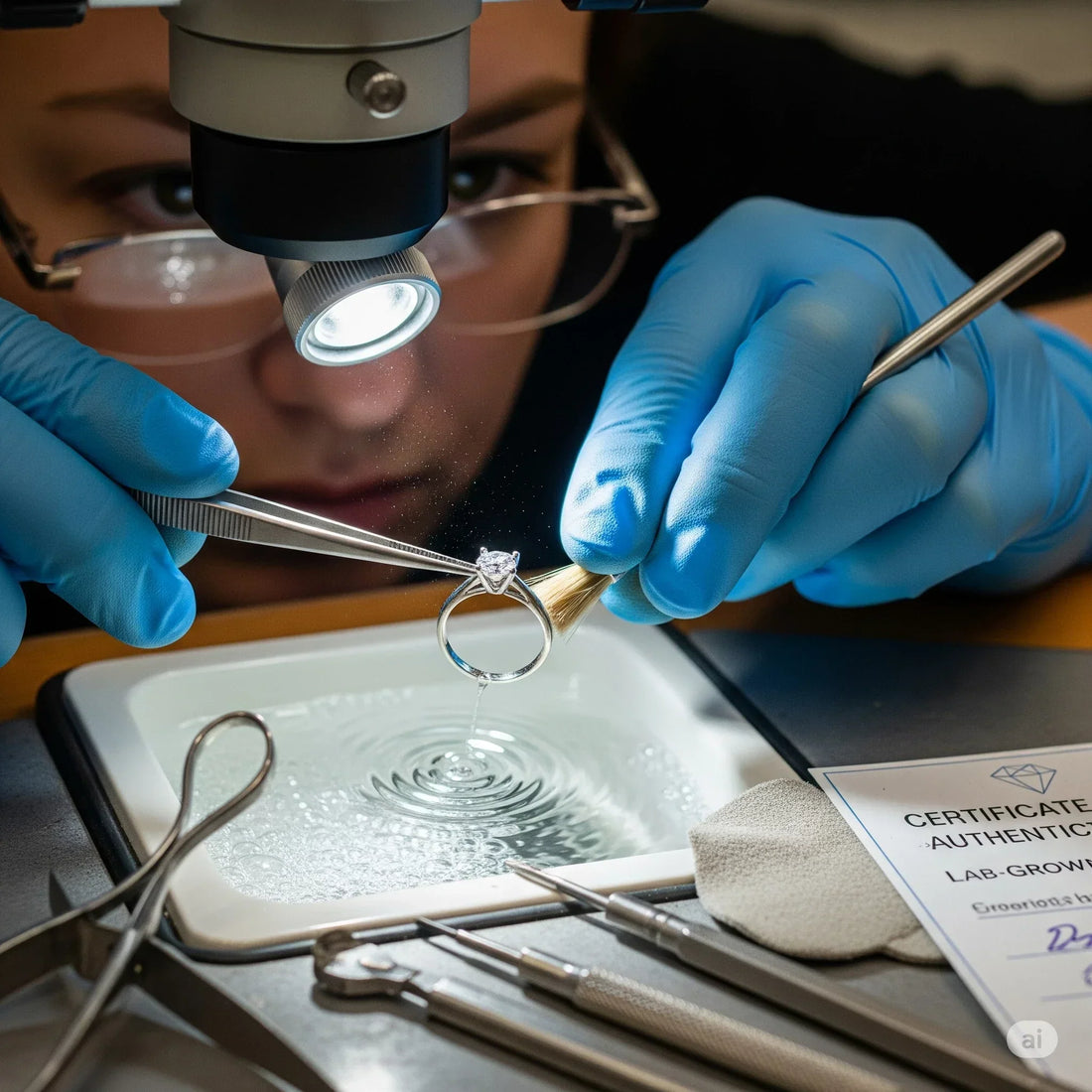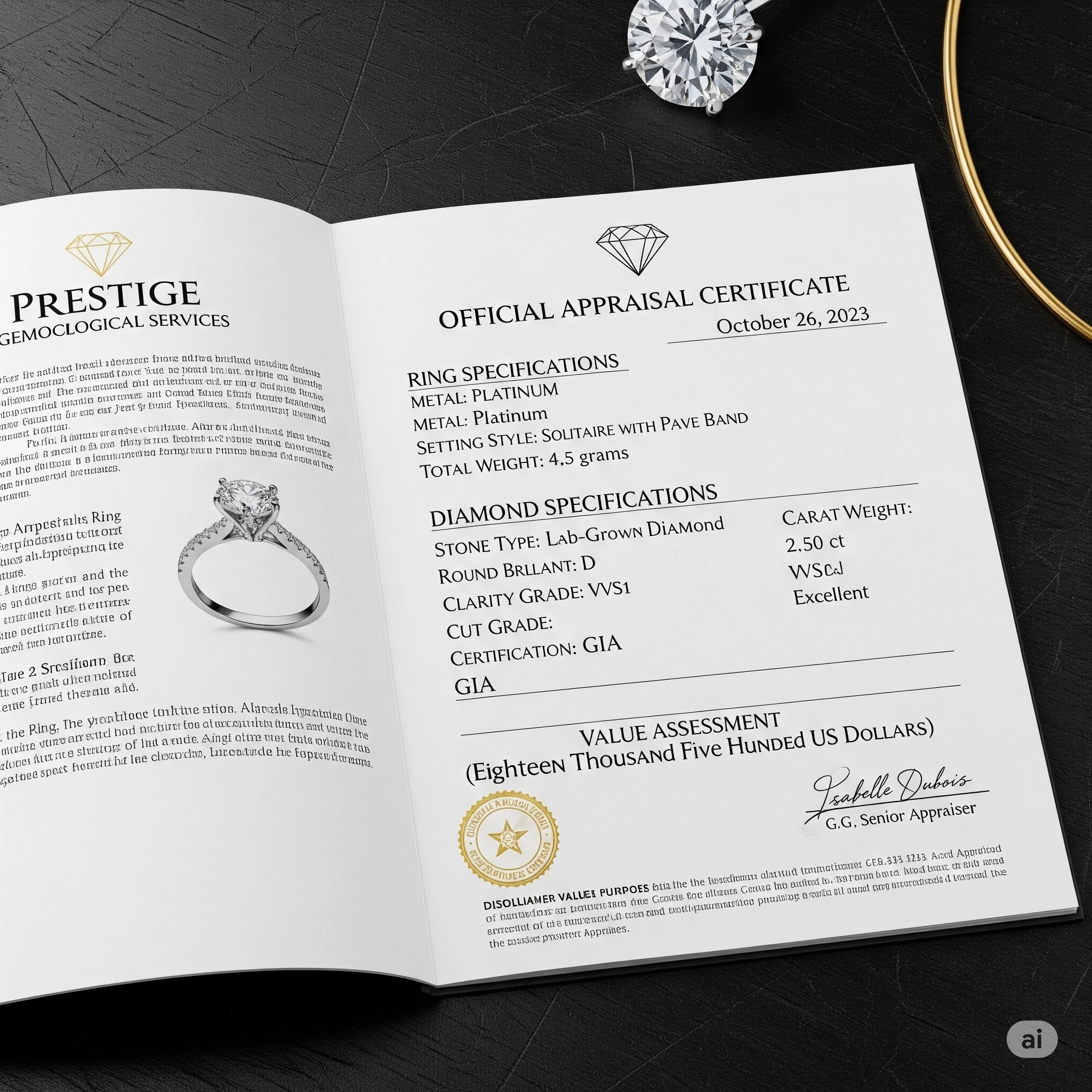
Are Lab Grown Diamonds Good for Engagement Rings? Expert Insights
Share
When considering are lab grown diamonds good for engagement rings, couples today face an exciting array of choices that didn't exist for previous generations. Lab-grown diamonds have emerged as a compelling alternative to mined diamonds, offering identical physical, chemical, and optical properties at a fraction of the cost. These scientifically created gems provide the same brilliance, fire, and scintillation as their earth-mined counterparts while addressing many concerns about ethical sourcing and environmental impact.
The engagement ring market has witnessed a significant shift toward lab-grown diamonds, with sales increasing by over 15% annually. This growth reflects changing consumer priorities, particularly among millennials and Gen Z couples who value sustainability, transparency, and value. Understanding the benefits and considerations of lab-grown diamonds helps couples make informed decisions about one of their most important purchases.

Understanding Lab-Grown Diamonds
Lab-grown diamonds are real diamonds created in controlled laboratory environments using advanced technological processes that replicate the natural conditions under which diamonds form in the Earth's mantle. Two primary methods produce these gems: High Pressure High Temperature (HPHT) and Chemical Vapor Deposition (CVD).
The Science Behind Lab Diamond Creation
The HPHT method recreates the extreme pressure and temperature conditions found deep within the Earth, using specialized presses that generate pressures exceeding 1.5 million pounds per square inch and temperatures above 2,700 degrees Fahrenheit. A small diamond seed is placed in carbon, which transforms into a larger diamond over several weeks.
CVD technology uses a different approach, placing a diamond seed in a sealed chamber filled with carbon-rich gas. The gas is heated to extremely high temperatures, causing carbon atoms to separate and deposit onto the seed, gradually building layers to form a diamond crystal.
Physical and Chemical Properties
Lab-grown diamonds possess identical physical, chemical, and optical properties to mined diamonds. They score 10 on the Mohs hardness scale, exhibit the same refractive index of 2.42, and display identical fire and brilliance. Professional gemologists require specialized equipment to distinguish between lab-grown and mined diamonds, as they are chemically identical carbon crystals.

Advantages of Lab-Grown Diamonds for Engagement Rings
Exceptional Value and Affordability
One of the most compelling reasons couples choose lab-grown diamonds is their exceptional value proposition. Lab-grown diamonds typically cost 30-50% less than comparable mined diamonds, allowing couples to purchase larger, higher-quality stones within their budget. This price advantage enables investment in superior lab diamond quality characteristics such as better clarity, color, or carat weight.
The cost savings extend beyond the initial purchase, as couples can allocate more budget toward custom settings, wedding bands, or other wedding expenses. Many couples use the savings to upgrade from a one-carat to a two-carat diamond, significantly enhancing the visual impact of their engagement ring.
Ethical and Environmental Benefits
Lab-grown diamonds address ethical concerns associated with diamond mining, including labor practices and conflict diamonds. The controlled laboratory environment ensures transparent sourcing and eliminates concerns about supporting regions affected by diamond-related conflicts.
Environmental considerations also favor lab-grown diamonds. While both mining and laboratory creation require energy, lab-grown diamonds have a significantly smaller environmental footprint. Mining operations require extensive land disruption, water usage, and ecosystem displacement, while laboratory creation occurs in controlled facilities with minimal environmental impact.
Quality and Consistency
The controlled laboratory environment allows for consistent production of high-quality diamonds. Lab-grown diamonds often exhibit fewer inclusions and better color consistency than mined diamonds, as the creation process eliminates many variables present in natural formation. This consistency means couples can more easily find diamonds meeting specific quality criteria.

Comparing Lab-Grown and Mined Diamonds
Visual Appearance and Performance
When comparing lab-grown and mined diamonds side by side, even trained professionals cannot distinguish between them without specialized equipment. Both exhibit identical optical properties, including brilliance, fire, and scintillation. The sparkle, light performance, and overall visual appeal remain indistinguishable to the naked eye.
Cut quality affects both types equally, with well-cut lab-grown diamonds displaying the same exceptional light performance as well-cut mined diamonds. The four Cs (cut, color, clarity, and carat weight) apply equally to both diamond types, with grading standards remaining consistent.
Durability and Longevity
Lab-grown diamonds offer identical durability to mined diamonds, scoring 10 on the Mohs hardness scale. They resist scratching, chipping, and everyday wear equally well, making them suitable for daily wear in engagement rings. The chemical composition ensures lab-grown diamonds maintain their brilliance and structural integrity over decades.
Proper care and maintenance requirements remain identical for both diamond types. Regular cleaning, professional inspections, and appropriate storage preserve the beauty and integrity of lab-grown diamonds just as effectively as mined diamonds.
Certification and Grading
Reputable gemological institutes, including the Gemological Institute of America (GIA) and International Gemological Institute (IGI), grade lab-grown diamonds using the same standards applied to mined diamonds. Certificates clearly identify diamonds as laboratory-grown and provide detailed assessments of cut, color, clarity, and carat weight.
These certifications ensure transparency and provide confidence in diamond quality. Couples should always request certified lab-grown diamonds to verify authenticity and quality characteristics.

Engagement Ring Options with Lab-Grown Diamonds
Setting Styles and Design Flexibility
Lab-grown diamonds work beautifully in all traditional and contemporary engagement ring options. Popular settings include solitaire, halo, three-stone, vintage-inspired, and modern geometric designs. The cost savings from choosing lab-grown diamonds often allows couples to invest in more elaborate settings or premium metals like platinum.
Custom design opportunities expand significantly with lab-grown diamonds. Couples can work with jewelers to create unique, personalized rings incorporating specific design elements, colored lab-grown diamonds, or complex multi-stone arrangements that might be cost-prohibitive with mined diamonds.
Popular Cuts and Shapes
Lab-grown diamonds are available in all popular cuts and shapes, including round brilliant, princess, emerald, asscher, oval, marquise, pear, cushion, and radiant cuts. The controlled creation process often produces rough diamonds suitable for various cuts, providing excellent selection options.
Fancy colored lab-grown diamonds offer additional creative possibilities. Laboratory processes can produce vivid yellows, blues, pinks, and other colors that are extremely rare and expensive in mined diamonds, opening new design possibilities for unique engagement rings.
Size and Budget Considerations
The affordability of lab-grown diamonds allows couples to consider larger stones within their budget. A couple with a $5,000 budget might choose between a 0.75-carat mined diamond or a 1.25-carat lab-grown diamond of comparable quality, significantly impacting the ring's visual presence.
Budget allocation becomes more flexible with lab-grown diamonds. Couples can prioritize different aspects of their ring, such as upgrading to a higher color grade, better clarity, or more elaborate setting design while maintaining their overall budget.

Quality Factors to Consider
The Four Cs in Lab-Grown Diamonds
Cut quality remains the most important factor affecting a lab-grown diamond's beauty and brilliance. Excellent cut grades maximize light performance, creating superior sparkle and fire. Couples should prioritize cut quality over other factors when selecting lab-grown diamonds.
Color grades in lab-grown diamonds follow the same D-Z scale used for mined diamonds. The controlled creation process often produces diamonds with excellent color consistency, making it easier to find stones in desirable color ranges. Near-colorless grades (G-I) offer excellent value while maintaining beautiful appearance.
Clarity characteristics in lab-grown diamonds may differ slightly from mined diamonds, but grading standards remain consistent. The controlled environment often results in fewer inclusions, making it easier to find diamonds with higher clarity grades at competitive prices.
Certification and Documentation
Proper certification ensures confidence in lab diamond quality and authenticity. Reputable grading laboratories provide detailed reports documenting all quality characteristics and clearly identifying diamonds as laboratory-grown. These certificates serve as permanent records of diamond specifications and quality.
Couples should verify that their chosen lab-grown diamond includes certification from recognized gemological institutes. This documentation proves authenticity, quality, and provides important information for insurance and future appraisals.
Selecting the Right Quality Grade
Balancing quality factors with budget considerations helps couples make optimal choices. For engagement rings, prioritizing cut quality ensures maximum brilliance, while selecting appropriate color and clarity grades based on personal preferences and budget constraints creates the best overall value.
Professional guidance from experienced jewelers helps couples understand how different quality combinations affect appearance and value. Seeing diamonds in person allows for informed comparisons and confident decision-making.

Long-Term Value and Investment Considerations
Resale Value Reality
Understanding resale value helps couples make informed decisions about lab-grown diamonds. Currently, lab-grown diamonds have lower resale values compared to mined diamonds, primarily due to market perceptions and the continuous improvement in production efficiency that keeps prices competitive.
However, engagement rings are typically purchased for emotional significance rather than investment purposes. The substantial initial savings from choosing lab-grown diamonds often offset lower resale values, particularly when considering the total cost of ownership over time.
Market Trends and Future Outlook
The lab-grown diamond market continues evolving rapidly, with increasing consumer acceptance and technological improvements. Major jewelry retailers now offer extensive lab-grown diamond collections, indicating growing mainstream acceptance and market maturity.
Future market developments may affect value retention, but the primary benefits of lab-grown diamonds—affordability, ethical sourcing, and identical beauty—remain compelling regardless of market fluctuations. Couples choosing lab-grown diamonds for these reasons typically find long-term satisfaction with their decision.
Insurance and Appraisal Considerations
Lab-grown diamonds require the same insurance coverage as mined diamonds, protecting against loss, theft, or damage. Insurance companies typically base coverage on certified appraised values, making proper documentation essential.
Regular appraisals ensure adequate insurance coverage and provide updated valuations reflecting current market conditions. Professional appraisers familiar with lab-grown diamonds provide accurate assessments for insurance and estate planning purposes.

Shopping Tips for Lab-Grown Diamond Engagement Rings
Choosing Reputable Retailers
Selecting established retailers with expertise in lab-grown diamonds ensures quality products and professional service. Look for jewelers offering certified diamonds, comprehensive warranties, and knowledgeable staff who can explain the differences between various options.
Online retailers often provide extensive selections and competitive pricing, while local jewelers offer personalized service and the ability to examine diamonds in person. Many couples benefit from combining online research with in-person consultations to make informed decisions.
Questions to Ask Jewelers
Important questions include asking about certification sources, return policies, warranty coverage, and customization options. Understanding the jeweler's expertise with lab-grown diamonds and their ability to provide ongoing service ensures a positive long-term relationship.
Inquire about the specific creation method (HPHT or CVD) and any treatments applied to the diamond. Reputable jewelers provide complete transparency about their products and can explain how different factors affect quality and value.
Timing and Budget Planning
Lab-grown diamond prices remain relatively stable compared to mined diamond market fluctuations, making timing less critical for purchase decisions. However, allowing adequate time for custom work or special orders ensures availability for important dates.
Budget planning should include the complete ring cost, including setting, sizing, insurance, and any customization work. The savings from lab-grown diamonds often allow for upgrades in other areas while maintaining overall budget targets.

Care and Maintenance
Daily Care Practices
Lab-grown diamonds require the same care as mined diamonds to maintain their brilliance and beauty. Regular cleaning with mild soap and warm water removes oils and debris that can dull the diamond's sparkle. Soft brushes help clean hard-to-reach areas around settings.
Avoiding harsh chemicals and extreme temperatures protects both the diamond and setting materials. Removing rings during activities that might cause impact or exposure to chemicals preserves the ring's condition and prevents damage.
Professional Maintenance
Annual professional cleanings and inspections ensure optimal appearance and structural integrity. Jewelers can identify potential issues with settings, prongs, or other components before they become serious problems requiring expensive repairs.
Professional cleaning services restore maximum brilliance and fire to lab-grown diamonds, removing buildup that home cleaning cannot address. These services often include complimentary inspections and minor adjustments.
Storage and Protection
Proper storage prevents scratching and damage when rings are not being worn. Individual compartments or soft pouches separate jewelry pieces and prevent contact that could cause scratching or tangling.
Safe storage locations protect valuable jewelry from theft while ensuring easy access for regular wear. Home safes or safety deposit boxes provide security for especially valuable pieces during extended periods of non-wear.

Common Myths and Misconceptions
Addressing Quality Concerns
Some consumers worry that lab-grown diamonds are inferior to mined diamonds, but this misconception stems from misunderstanding the creation process. Lab-grown diamonds are real diamonds with identical physical, chemical, and optical properties to mined diamonds.
Quality variations exist within both lab-grown and mined diamonds, making individual assessment more important than origin. Well-cut, high-quality lab-grown diamonds often outperform poorly cut mined diamonds in terms of brilliance and beauty.
Durability Myths
Lab-grown diamonds possess identical hardness and durability to mined diamonds, scoring 10 on the Mohs scale. They resist scratching, chipping, and everyday wear equally well, making them suitable for lifetime wear in engagement rings.
The controlled creation environment often results in fewer structural weaknesses compared to mined diamonds, which may contain natural stress points or inclusions that could affect durability over time.
Value Perception Issues
While lab-grown diamonds currently have lower resale values, their initial affordability often provides better overall value for couples prioritizing beauty, size, and quality over potential future resale. The substantial savings allow for larger, higher-quality diamonds within budget constraints.
Market acceptance continues growing, with major retailers and designers embracing lab-grown diamonds. This increasing acceptance may positively affect future value retention as the market matures.

Frequently Asked Questions
Are lab-grown diamonds real diamonds?
Yes, lab-grown diamonds are real diamonds with identical chemical, physical, and optical properties to mined diamonds. They are composed of pure carbon arranged in the same crystal structure and exhibit the same hardness, brilliance, and fire as natural diamonds.
How can you tell the difference between lab-grown and mined diamonds?
Professional gemologists require specialized equipment to distinguish between lab-grown and mined diamonds. To the naked eye, they appear identical. Certified diamonds include clear identification of their origin on grading reports.
Do lab-grown diamonds lose their sparkle over time?
No, lab-grown diamonds maintain their brilliance and sparkle indefinitely, just like mined diamonds. With proper care and occasional professional cleaning, they will look as beautiful decades from now as they do today.
Are lab-grown diamonds a good investment?
Lab-grown diamonds are primarily purchased for their beauty and emotional significance rather than investment purposes. While they currently have lower resale values than mined diamonds, their substantial initial savings often provide better overall value for engagement ring purchases.
Can lab-grown diamonds be insured?
Yes, lab-grown diamonds can and should be insured just like mined diamonds. Insurance companies provide coverage based on certified appraised values, protecting against loss, theft, or damage.
What sizes are available in lab-grown diamonds?
Lab-grown diamonds are available in sizes ranging from small accent stones to large center stones exceeding 5 carats. The controlled creation process allows for consistent production of various sizes to meet different preferences and budgets.
How long does it take to create a lab-grown diamond?
The creation process typically takes 6-10 weeks, depending on the desired size and quality. This controlled timeline allows for consistent production and availability compared to the unpredictable discovery of mined diamonds.
Are colored lab-grown diamonds available?
Yes, lab-grown diamonds are available in various colors including yellow, blue, pink, and other fancy colors. The controlled creation process can produce vivid colors that are extremely rare and expensive in mined diamonds.

Making Your Decision
Choosing between lab-grown and mined diamonds for engagement rings ultimately depends on personal priorities, values, and budget considerations. Lab-grown diamonds offer compelling advantages including exceptional value, ethical sourcing, environmental benefits, and identical beauty to mined diamonds.
Couples prioritizing maximum size and quality within their budget often find lab-grown diamonds provide superior value. Those concerned about ethical sourcing and environmental impact appreciate the transparent, controlled creation process. The identical physical properties ensure lab-grown diamonds deliver the same symbolic significance and lasting beauty expected from engagement rings.
Consider your long-term priorities when making this important decision. If maximizing diamond size, quality, and ethical sourcing within budget constraints aligns with your values, lab-grown diamonds represent an excellent choice for engagement rings. The substantial savings can be allocated toward other wedding expenses, custom settings, or simply provide financial flexibility for your future together.
Professional guidance from experienced jewelers helps navigate the selection process and ensures you find the perfect diamond for your unique situation. Take time to examine different options, ask questions, and make an informed decision that reflects your personal values and preferences.

Ready to Find Your Perfect Lab-Grown Diamond?
Lab-grown diamonds offer an exceptional combination of beauty, value, and ethical sourcing that makes them an outstanding choice for engagement rings. With identical physical properties to mined diamonds at significantly lower prices, they allow couples to maximize their budget while maintaining uncompromising quality and brilliance.
Take the next step toward finding your perfect engagement ring today. Visit our showroom to see the stunning beauty of lab-grown diamonds in person, or browse our extensive online collection to explore the latest styles and settings. Our certified gemologists are ready to help you navigate the selection process and find a diamond that perfectly represents your love story.
Don't let budget constraints limit your dreams. With lab-grown diamonds, you can have the size, quality, and beauty you've always envisioned for your engagement ring while staying within your budget and supporting ethical practices. Schedule your consultation today and discover why thousands of couples are choosing lab-grown diamonds for their forever rings.
Contact us now to begin your journey toward the perfect engagement ring. Your dream diamond is waiting, and our experts are here to make your vision a reality with the exceptional value and beauty that only lab-grown diamonds can provide.
